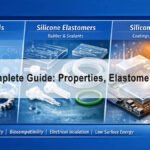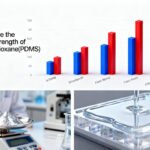Liquid Silicone Rubber (LSR) – Properties & Uses
- Blog
- August 26, 2025
- 10:27 am
Liquid Silicone Rubber (LSR) is a high-performance elastomer derived from polysiloxane polymers. Unlike traditional solid silicone, LSR is supplied in a liquid form, which offers excellent flowability and allows it to be processed via advanced molding techniques such as liquid silicone rubber injection molding. Once cured, LSR exhibits exceptional elasticity, transparency, and long-term durability, making it suitable for demanding applications across medical, automotive, food, and electronics industries.
Table of Contents
1. Classification of Liquid Silicone Rubber
1.1 By Component System
One-component LSR: Pre-mixed and ready to use; typically used in small-scale or DIY applications.
Two-component LSR (A/B type): Requires precise mixing of two parts, commonly in a 1:1 or 10:1 ratio, and is widely used in industrial production.
1.2 By Curing Mechanism
Addition-cure LSR (Platinum-catalyzed): Features low shrinkage, no by-products, and superior resistance to heat, chemicals, and weathering.
Condensation-cure LSR (RTV silicone): Produces small by-products (e.g., alcohol, acetic acid) during curing, commonly used for mold making and prototyping.
1.3 By Application
Mold making silicone rubber (precision molding, prototyping)
Pad printing silicone rubber (transfer printing pads)
Electronic encapsulation silicone (for insulation and waterproofing)
Food-grade LSR (baking molds, baby products)
Medical-grade LSR (catheters, implants, seals)
High-temperature LSR (engine gaskets, automotive seals)
Cosmetic & prosthetic LSR (skin-contact safe silicone for artificial limbs)
2. Key Advantages of Liquid Silicone Rubber
Outstanding Transparency and Precision
LSR offers high optical clarity, tear strength, and resistance to yellowing. Its low shrinkage rate (≤0.1%) ensures high precision, even in complex mold structures.Wide Temperature Resistance
Performs reliably from –68 °C (–155 °F) to over 200 °C (392 °F), making it ideal for extreme environments.Biocompatibility and Safety
Certified to FDA, RoHS, and ISO standards; safe for food contact applications and medical devices. It is odorless, tasteless, and resistant to bacterial growth.Electrical Insulation Properties
Excellent dielectric strength, widely used in electronic keypads, connectors, and sealing components.High Processing Efficiency
LSR supports automated injection molding, enabling mass production with reduced labor cost and minimal material waste.Eco-Friendly and Sustainable
Curing produces no toxic by-products, and material waste is significantly lower compared to conventional rubbers.
3. Processing and Usage Methods of Liquid Silicone Rubber
3.1 General Usage
One-component LSR: Ready-to-use; simply extruded or applied directly.
Two-component LSR: Mix components A and B, degas under vacuum, pour into mold, and allow to cure (heat or room temperature).
3.2 Common Molding Processes
Injection Molding (LIM): High precision, ideal for large-scale production of medical devices, automotive parts, and electronic components.
Casting / Pouring: Suitable for low-viscosity silicone in smaller-scale mold making.
Compression Molding: Used for medium-volume production, especially when embedding inserts.
Rotational Molding: Produces hollow, uniform-thickness parts such as seals and bellows.
3.3 Bonding and Adhesion
Bonding LSR to metals, plastics, or glass can be achieved using specialized silicone adhesives or surface treatments, ensuring strong adhesion for hybrid parts.
4. Common Types of Liquid Silicone Rubber and Applications
Food-grade LSR – Baby nipples, baking molds, kitchenware (safe, high-transparency, FDA compliant).
Medical-grade LSR – Catheters, seals, prosthetic devices (excellent biocompatibility).
Automotive-grade LSR – High-temperature gaskets, connectors, vibration dampers.
Electronics-grade LSR – Keypads, waterproof seals, sensor encapsulation.
Industrial mold-making LSR – Precision molds, prototypes, replicas.
Specialty high-temperature LSR – Suitable for aerospace and industrial sealing applications.
Conclusion
Liquid Silicone Rubber (LSR) is one of the most versatile and high-performance materials in modern manufacturing. With its excellent transparency, wide temperature resistance, superior biocompatibility, and outstanding molding precision, it has become indispensable in industries ranging from medical devices and automotive sealing to food-grade consumer products and electronic insulation.
Silicone rubber related articles
Popular Recommendations
Get a Catalog & Best Price
- Quick and helpful reply within 24 hours;
- Tailored solutions provided for your project;
- One-stop purchasing service.
TRENDING
Silico® ORGANOSILICON
- Address: Daiyue Industrial Area, Taian, Shandong, China



